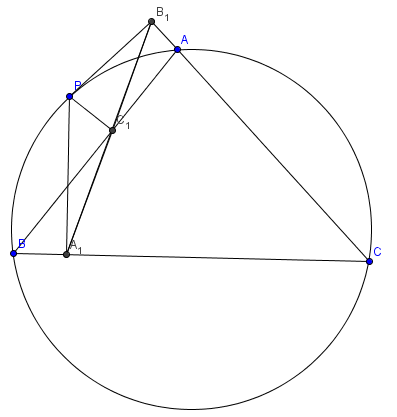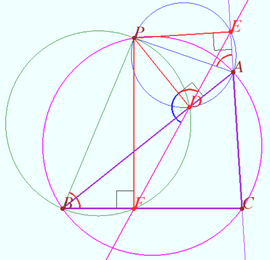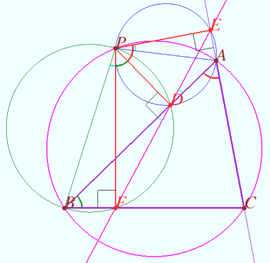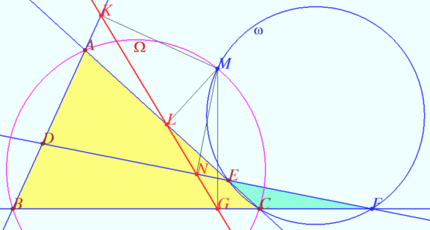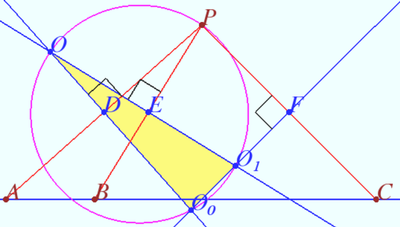Difference between revisions of "Simson line"
Black flash5 (talk | contribs) (→Baler line 🗿🗿 (main)) |
(Formatting) |
||
| Line 1: | Line 1: | ||
| − | In [[geometry]], given a [[triangle]] ABC and a point P on its [[circumcircle]], the three closest points to P on lines AB, AC, and BC are [[collinear]]. | + | In [[geometry]], given a [[triangle]] ABC and a point P on its [[circumcircle]], the three closest points to P on lines AB, AC, and BC are [[collinear]] and form a '''Simson line'''. |
| + | |||
[[File:Simsonline.png]] | [[File:Simsonline.png]] | ||
| − | == | + | == Definition == |
| + | |||
| + | [[File:Simson line.png|270px|right]] | ||
| + | [[File:Simson line inverse.png|270px|right]] | ||
Let a triangle <math>\triangle ABC</math> and a point <math>P</math> be given. | Let a triangle <math>\triangle ABC</math> and a point <math>P</math> be given. | ||
| Line 9: | Line 13: | ||
Then points <math>D, E,</math> and <math>F</math> are collinear iff the point <math>P</math> lies on circumcircle of <math>\triangle ABC.</math> | Then points <math>D, E,</math> and <math>F</math> are collinear iff the point <math>P</math> lies on circumcircle of <math>\triangle ABC.</math> | ||
| − | + | === Proof of existence === | |
Let the point <math>P</math> be on the circumcircle of <math>\triangle ABC.</math> | Let the point <math>P</math> be on the circumcircle of <math>\triangle ABC.</math> | ||
| Line 39: | Line 43: | ||
<math>ACBP</math> is cyclis as desired. | <math>ACBP</math> is cyclis as desired. | ||
| − | + | == Simson line of a complete quadrilateral == | |
| − | |||
[[File:Simson complite.png|430px|right]] | [[File:Simson complite.png|430px|right]] | ||
Let four lines made four triangles of a complete quadrilateral. In the diagram these are <math>\triangle ABC, \triangle ADE, \triangle CEF, \triangle BDF.</math> | Let four lines made four triangles of a complete quadrilateral. In the diagram these are <math>\triangle ABC, \triangle ADE, \triangle CEF, \triangle BDF.</math> | ||
| Line 51: | Line 54: | ||
Prove that points <math>K,L, N,</math> and <math>G</math> are collinear. | Prove that points <math>K,L, N,</math> and <math>G</math> are collinear. | ||
| − | + | === Proof === | |
Let <math>\Omega</math> be the circumcircle of <math>\triangle ABC, \omega</math> be the circumcircle of <math>\triangle CEF.</math> Then <math>M = \Omega \cap \omega.</math> | Let <math>\Omega</math> be the circumcircle of <math>\triangle ABC, \omega</math> be the circumcircle of <math>\triangle CEF.</math> Then <math>M = \Omega \cap \omega.</math> | ||
| Line 61: | Line 64: | ||
Therefore points <math>K, L, N,</math> and <math>G</math> are collinear, as desired. | Therefore points <math>K, L, N,</math> and <math>G</math> are collinear, as desired. | ||
| − | + | == Problems == | |
| − | |||
| − | |||
| − | |||
[[File:Problem on Simson line.png |400px|right]] | [[File:Problem on Simson line.png |400px|right]] | ||
| − | Let the points <math>A, B,</math> and <math>C</math> be collinear and the point <math>P \notin AB.</math> | + | *Let the points <math>A, B,</math> and <math>C</math> be collinear and the point <math>P \notin AB</math>. Let <math>O,O_0,</math> and <math>O_1</math> be the circumcenters of triangles <math>\triangle ABP, \triangle ACP,</math> and <math>\triangle BCP</math>. Prove that <math>P</math> lies on circumcircle of <math>\triangle OO_0O_1</math>. |
| − | Let <math> | + | ** Solution |
| + | : Let <math>D, E,</math> and <math>F</math> be the midpoints of segments <math>AB, AC,</math> and <math>BC,</math> respectively. Then points <math>D, E,</math> and <math>F</math> are collinear <math>(DE||AB, EF||DC).</math> | ||
| + | <cmath>PD \perp OO_0, PE \perp OO_1, PF \perp O_0O_1 \implies</cmath> | ||
| + | :<math>DEF</math> is Simson line of <math>\triangle OO_0O_1 \implies P</math> lies on circumcircle of <math>\triangle OO_0O_1</math> as desired. | ||
| − | + | == See Also == | |
| − | + | *[[Miquel's point]] | |
| − | + | *[[Steiner line]] | |
| + | *[[Euler line]] | ||
| − | |||
| − | + | {{stub}} | |
| − | |||
| − | |||
| − | |||
| − | |||
| − | |||
Latest revision as of 18:48, 18 April 2025
In geometry, given a triangle ABC and a point P on its circumcircle, the three closest points to P on lines AB, AC, and BC are collinear and form a Simson line.
Contents
Definition
Let a triangle ![]() and a point
and a point ![]() be given.
be given.
Let ![]() and
and ![]() be the foots of the perpendiculars dropped from P to lines AB, AC, and BC, respectively.
be the foots of the perpendiculars dropped from P to lines AB, AC, and BC, respectively.
Then points ![]() and
and ![]() are collinear iff the point
are collinear iff the point ![]() lies on circumcircle of
lies on circumcircle of ![]()
Proof of existence
Let the point ![]() be on the circumcircle of
be on the circumcircle of ![]()
![]()
![]() is cyclic
is cyclic ![]()
![]()
![]() is cyclic
is cyclic ![]()
![]() is cyclic
is cyclic ![]()
![]() and
and ![]() are collinear as desired.
are collinear as desired.
Proof
Let the points ![]() and
and ![]() be collinear.
be collinear.
![]() is cyclic
is cyclic ![]()
![]() is cyclic
is cyclic ![]()
![]()
![]()
![]() is cyclis as desired.
is cyclis as desired.
Simson line of a complete quadrilateral
Let four lines made four triangles of a complete quadrilateral. In the diagram these are ![]()
Let ![]() be the Miquel point of a complete quadrilateral.
be the Miquel point of a complete quadrilateral.
Let ![]() and
and ![]() be the foots of the perpendiculars dropped from
be the foots of the perpendiculars dropped from ![]() to lines
to lines ![]() and
and ![]() respectively.
respectively.
Prove that points ![]() and
and ![]() are collinear.
are collinear.
Proof
Let ![]() be the circumcircle of
be the circumcircle of ![]() be the circumcircle of
be the circumcircle of ![]() Then
Then ![]()
Points ![]() and
and ![]() are collinear as Simson line of
are collinear as Simson line of ![]()
Points ![]() and
and ![]() are collinear as Simson line of
are collinear as Simson line of ![]()
Therefore points ![]() and
and ![]() are collinear, as desired.
are collinear, as desired.
Problems
- Let the points
 and
and  be collinear and the point
be collinear and the point  . Let
. Let  and
and  be the circumcenters of triangles
be the circumcenters of triangles  and
and  . Prove that
. Prove that  lies on circumcircle of
lies on circumcircle of  .
.
- Solution
- Let
 and
and  be the midpoints of segments
be the midpoints of segments  and
and  respectively. Then points
respectively. Then points  and
and  are collinear
are collinear 
![]()
 is Simson line of
is Simson line of  lies on circumcircle of
lies on circumcircle of  as desired.
as desired.
See Also
This article is a stub. Help us out by expanding it.





